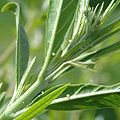Monarch butterfly: Difference between revisions
m Reverted edits by 199.0.205.237 (talk) to last version by 71.62.3.38 |
|||
| Line 102: | Line 102: | ||
The monarch is the [[List of U.S. state insects|state insect]] of Alabama,<ref>{{cite web |url=http://www.archives.state.al.us/emblems/st_insec.html |title=Official Alabama Insect |accessdate=2007-03-19 |date=[[2001-07-12]] |work=Alabama Emblems, Symbols and Honors |publisher=Alabama Department of Archives & History}}</ref> Idaho,<ref>{{cite web |url=http://www.shgresources.com/id/symbols/insect/ |title=Idaho Symbols, Insect: Monarch Butterfly |accessdate=2008-03-26 |work=Idaho State Symbols, Emblems, and Mascots |publisher=SHG resources, state handbook & guide}}</ref> Illinois,<ref>{{cite web |url=http://www.museum.state.il.us/exhibits/symbols/insect.html |title=State Symbol: Illinois Official Insect — Monarch Butterfly (''Danaus plexippus'') |accessdate=2008-03-26 |work=[Illinois] State Symbols |publisher=Illinois State Museum}}</ref> Minnesota,<ref>{{cite web |url= http://www.house.leg.state.mn.us/hinfo/govser/GOVSER2.pdf |format=PDF |accessdate=2008-03-26 |title=Minnesota State Symbols |publisher= Minnesota House of Representatives}}</ref> Texas,<ref>{{cite web |url=http://www.tsl.state.tx.us/ref/abouttx/symbols.html |accessdate=2008-03-26 |title=Texas State Symbols |publisher=The Texas State Library and Archives}}</ref> and the [[List of U.S. state butterflies|state butterfly]] of Vermont<ref>{{cite web |url=http://www.libraries.vermont.gov/www/html/emblems/butterfly.htm |accessdate=2008-03-26 |title=(Vermont) State Butterfly |publisher=Vermont Department of Libraries}}</ref> and West Virginia.<ref>{{cite web |url=http://www.wv.gov/govdirectory/statgeninfo.pdf |accessdate=2008-03-26 |format=PDF |title=West Virginia Statistical Information, General State Information |publisher=Official West Virginia Web Portal}}</ref> It was nominated in 1990 as the national insect of the [[United States|United States of America]], along with the honeybee (''[[Apis mellifera]]''),<ref>{{cite news |first=Nicholas |last=Wade |title=Choosing a National Bug |publisher=[[The New York Times]] |date=1990-06-01 |accessdate=2008-03-26 |url=http://query.nytimes.com/gst/fullpage.html?res=9C0CE4D81439F932A35755C0A966958260}}</ref> but the legislation did not pass.<ref>{{cite web |url=http://www.entsoc.org/resources/faq.htm#triv7 |accessdate=2008-03-26 |title=Frequently Asked Questions on Entomology |publisher=Entomological Society of America}}</ref> |
The monarch is the [[List of U.S. state insects|state insect]] of Alabama,<ref>{{cite web |url=http://www.archives.state.al.us/emblems/st_insec.html |title=Official Alabama Insect |accessdate=2007-03-19 |date=[[2001-07-12]] |work=Alabama Emblems, Symbols and Honors |publisher=Alabama Department of Archives & History}}</ref> Idaho,<ref>{{cite web |url=http://www.shgresources.com/id/symbols/insect/ |title=Idaho Symbols, Insect: Monarch Butterfly |accessdate=2008-03-26 |work=Idaho State Symbols, Emblems, and Mascots |publisher=SHG resources, state handbook & guide}}</ref> Illinois,<ref>{{cite web |url=http://www.museum.state.il.us/exhibits/symbols/insect.html |title=State Symbol: Illinois Official Insect — Monarch Butterfly (''Danaus plexippus'') |accessdate=2008-03-26 |work=[Illinois] State Symbols |publisher=Illinois State Museum}}</ref> Minnesota,<ref>{{cite web |url= http://www.house.leg.state.mn.us/hinfo/govser/GOVSER2.pdf |format=PDF |accessdate=2008-03-26 |title=Minnesota State Symbols |publisher= Minnesota House of Representatives}}</ref> Texas,<ref>{{cite web |url=http://www.tsl.state.tx.us/ref/abouttx/symbols.html |accessdate=2008-03-26 |title=Texas State Symbols |publisher=The Texas State Library and Archives}}</ref> and the [[List of U.S. state butterflies|state butterfly]] of Vermont<ref>{{cite web |url=http://www.libraries.vermont.gov/www/html/emblems/butterfly.htm |accessdate=2008-03-26 |title=(Vermont) State Butterfly |publisher=Vermont Department of Libraries}}</ref> and West Virginia.<ref>{{cite web |url=http://www.wv.gov/govdirectory/statgeninfo.pdf |accessdate=2008-03-26 |format=PDF |title=West Virginia Statistical Information, General State Information |publisher=Official West Virginia Web Portal}}</ref> It was nominated in 1990 as the national insect of the [[United States|United States of America]], along with the honeybee (''[[Apis mellifera]]''),<ref>{{cite news |first=Nicholas |last=Wade |title=Choosing a National Bug |publisher=[[The New York Times]] |date=1990-06-01 |accessdate=2008-03-26 |url=http://query.nytimes.com/gst/fullpage.html?res=9C0CE4D81439F932A35755C0A966958260}}</ref> but the legislation did not pass.<ref>{{cite web |url=http://www.entsoc.org/resources/faq.htm#triv7 |accessdate=2008-03-26 |title=Frequently Asked Questions on Entomology |publisher=Entomological Society of America}}</ref> |
||
Many people like to attract monarchs by growing a [[Butterfly gardening|butterfly garden]]. Others enjoy raising them for pleasure or for educational purposes. For migrating flocks, sanctuaries have been created at favorite wintering locations.<ref>{{cite web |url= http://www.sciencedaily.com/videos/2005/0810-saving_butterflies.htm |title= Saving Butterflies |
Many people like to attract monarchs by growing a [[Butterfly gardening|butterfly garden]] with a [[Asclepias physocarpa|specific milkweed species]]. Others enjoy raising them for pleasure or for educational purposes. For migrating flocks, sanctuaries have been created at favorite wintering locations.<ref>{{cite web |url= http://www.sciencedaily.com/videos/2005/0810-saving_butterflies.htm |title= Saving Butterflies |
||
Insect Ecologist Spearheads Creation of Oases for Endangered Butterflies |accessdate=2008-05-27 |publisher= ScienceDaily |date=2005-01-01}}</ref> Even [[tourism]] revenue is thus generated. |
Insect Ecologist Spearheads Creation of Oases for Endangered Butterflies |accessdate=2008-05-27 |publisher= ScienceDaily |date=2005-01-01}}</ref> Even [[tourism]] revenue is thus generated. |
||
Revision as of 05:22, 8 October 2008
| Monarch | |
|---|---|
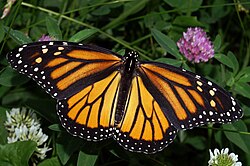
| |
| Female | |
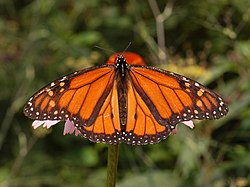
| |
| Male | |
| Scientific classification | |
| Kingdom: | |
| Phylum: | |
| Class: | |
| Order: | |
| Superfamily: | |
| Family: | |
| Subfamily: | |
| Tribe: | |
| Genus: | Kluk, 1780
|
| Species: | D. plexippus
|
| Binomial name | |
| Danaus plexippus (Linnaeus, 1758)
| |
| Synonyms | |
|
Danaus archippus (Fabricius, 1793)[1] | |
The monarch (Danaus plexippus) is a milkweed butterfly (subfamily Danainae), in the family Nymphalidae. It is perhaps the best known of all butterflies. Since the 19th century, it is also found in New Zealand, and has been known in Australia since 1871.[3] [4] In Australia it is also known as the wanderer butterfly.[5] In Europe it is resident in the Canary Islands and Madeira, and is found as a migrant in Russia, Azores, Sweden and Spain. Its wings feature an easily recognizable orange and black pattern, with a wingspan of 8.9–10.2 centimetres (3½–4 in).[6] (The viceroy butterfly has a similar size, color, and pattern, but can be distinguished by an extra black stripe across the hindwing.) Female monarchs have darker veins on their wings, and the males have a spot in the center of each hindwing[7] from which pheromones are released. Males are also slightly larger.
Taxonomy
The common name “monarch” was first published in 1874 by Samuel H. Scudder because “it is one of the largest of our butterflies, and rules a vast domain”.[8] But the name may be in honour of King William, Prince of Orange.[9] The monarch was one of the many species originally described by Linnaeus in his Systema Naturae of 1758. It was first placed in the genus Papilio.[10] In 1780, Jan Krzysztof Kluk used the monarch as the type species for a new genus; Danaus. Since Latin grammar requires that the specific epithet and gender names agree it is unclear if the genus Danaus is drawn from Danaus (Greek Δαναός), a mythical king of Egypt and great-grandson of Zeus or is a masculinised version of Danaë (Greek Δανάη), Danaus’s great-great-granddaughter. The species name, plexippus, refers to Plexippus, one of the 50 sons of Aegyptus, Danaus’ twin brother.[8][11]

The monarch is closely related to two very similar species which formed the Danaus (Danaus) subgenus before 2005. The first is the Jamaican monarch (D. cleophile) from Jamaica and Hispaniola. The second is the southern monarch (D. erippus), of South America south of the Amazon river. The southern monarch is almost indistinguishable from the monarch as an adult, the pupae are somewhat different, and is often considered a subspecies of the monarch proper. But analysis of morphological, mtDNA 12S rRNA, cytochrome c oxidase subunit I, nuclear DNA 18S rRNA and EF1 subunit α sequence data by Smith et al. (2005) indicates that it is better considered a distinct species. The separation of the monarch and southern monarch is comparatively recent. In all likelihood, the ancestors of the southern monarch separated from the monarch's population some 2 mya, at the end of the Pliocene. At the time sea levels were higher and the entire Amazonas lowland was a vast expanse of brackish swamp that offered hardly any butterfly habitat.[12]
Following the review of Smith et al. (2005), two sub-species of the monarch are recognized:[12]
- Danaus p. plexippus, the nominate subspecies, described by Linnaeus in 1758. It is the migratory subspecies known from most of North America.
- Danaus p. megalippe, named in 1826 by Jacob Hübner. It is the non-migratory subspecies, and is found from Florida and Georgia southwards, throughout the Caribbean and Central America to the Amazon River. Three local forms were at first considered to be other subspecies, but are actually colour varieties of D. p. megalippe:
- D. p. m. forma leucogyne, named by Arthur G. Butler in 1884.
- D. p. m. forma portoricensis, named in 1941 by A.H. Clark.
- D. p. m. forma tobagi, also named in 1941 by A.H. Clark.
Description
The monarch’s wingspan ranges from 8.9–10.2 centimetres (3½–4 in).[6] The upper side of the wings is tawny-orange, the veins and margins are black, and in the margins are two series of small white spots. The fore wings also have a few orange spots near the tip. The underside is similar but the tip of the forewing and hindwing are yellow-brown instead of tawny-orange and the white spots are larger.[13]
The male has a black patch of sex-scales on the hindwings, and the black veins on its wing are narrower than the female’s. The male is also slightly larger.[13]
The eggs are creamy white and later turn pale yellow. They are elongate and subconical, with approximately 23 longitudinal ridges and many fine traverse lines.[13] A single egg weighs about 0.46 milligrams (0.0071 gr), and measures about 1.2 millimetres (47 mils) high and 0.9 millimetres (35 mils) wide.[14][15]
Migration

Monarchs are especially noted for their lengthy annual migration. In North America they make massive southward migrations starting in August until the first frost. A northward migration takes place in the spring. (In Australia, they make limited migrations in cooler areas,[3] but the blue tiger butterfly is better known in Australia for its lengthy migration.[4] ) Female monarchs deposit eggs for the next generation during these migrations. By the end of October, the population of the Rocky Mountains migrates to the sanctuaries of the Mariposa Monarca Biosphere Reserve in the Mexican states of Michoacán and México. The western population overwinters in various sites in central coastal and southern California, United States, notably in Pacific Grove and Santa Cruz.
The length of these journeys exceeds the normal lifespan of most monarchs, which is less than two months for butterflies born in early summer. The last generation of the summer enters into a non-reproductive phase known as diapause and may live seven months or more.[7] During diapause, butterflies fly to one of many overwintering sites. The generation that overwinters generally does not reproduce until it leaves the overwintering site sometime in February and March. It is thought that the overwinter population of those east of the Rockies may reach as far north as Texas and Oklahoma during the spring migration. It is the second, third and fourth generations that return to their northern locations in the United States and Canada in the spring. How the species manages to return to the same overwintering spots over a gap of several generations is still a subject of research; the flight patterns appear to be inherited, based on a combination of circadian rhythm and the position of the sun in the sky.[16]
Monarch butterflies are one of the few insects capable of making transatlantic crossings. They are becoming more common in Bermuda due to increased usage of milkweed as an ornamental plant in flower gardens. Monarch butterflies born in Bermuda remain year round due to the island's mild climate.
A few monarchs turn up in the far southwest of Great Britain in years when the wind conditions are right, and have been sighted as far east as Long Bennington. Monarchs can also be found in New Zealand. On the islands of Hawaii no migrations have been noted.
Monarch butterflies are poisonous or distasteful to birds because of milkweed poison stored by the caterpillar stage; their bright colors are warning colors. During hibernation monarch butterflies sometimes suffer losses because hungry birds pick through them looking for the butterflies with the least amount of the poison onboard, but in the process killing those that they reject.
Reproduction
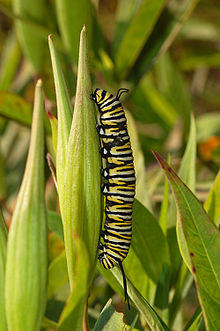
The mating period for the overwinter population occurs in the spring, just prior to migration from the overwintering sites. The courtship is fairly simple and less dependent on chemical pheromones in comparison with other species in its genus.[17] Courtship is composed of two distinct stages, the aerial phase and the ground phase. During the aerial phase, the male pursues, nudges, and eventually takes down the female. Copulation occurs during the ground phase and involves the transfer of a spermatophore from the male to the female. Along with sperm, the spermatophore is thought to provide the female with energy resources that aid her in carrying out reproduction and remigration. The overwinter population returns only as far north as they need to go to find the early milkweed growth; in the case of the eastern butterflies that is commonly southern Texas. The life cycle of a monarch includes a change of form called complete metamorphosis. The monarch goes through four radically different stages:
- The eggs are laid by the females during spring and summer breeding months.
- The eggs hatch (after 4 days), revealing worm-like larvae, the caterpillars. The caterpillars consume their egg cases, then feed on milkweed, and sequester substances called cardenolides, a type of cardiac glycoside. During the caterpillar stage, monarchs store energy in the form of fat and nutrients to carry them through the non-feeding pupa stage. The caterpiller stage lasts around 2 weeks.
- In the pupa or chrysalis stage, the caterpillar spins a silk pad on a twig, leaf, etc., and hangs from this pad by its last pair of prolegs. It hangs upside down in the shape of a 'J', and then molts, leaving itself encased in an articulated green exoskeleton. At this point, hormonal changes occur, leading to the development of a butterfly (metamorphosis). The chrysalis darkens (actually becomes transparent) a day before it emerges, and its orange and black wings can be seen.
- The mature butterfly emerges after about two pupal weeks and hangs from the split chrysalis for several hours until its wings are dry (often in the morning). Meanwhile fluids are pumped into the crinkled wings until they become full and stiff. Some of this orangey fluid (called meconium) drips from the wings. Finally (usually in the afternoon) the monarch spreads its wings, quivers them to be sure they are stiff, and then flies away, to feed on a variety of flowers, including milkweed flowers, red clover, and goldenrod.
Monarchs can live a life of two to eight weeks in a garden having their host Asclepias plants and sufficient flowers for nectar. This is especially true if the flower garden happens to be surrounded by native forest that seems to be lacking in flowers.
Pictorial lifecycle
-
Monarch male showing its wings to attract a mate
-
Monarch butterflies mating
-
Monarch butterfly laying eggs on Asclepias curassavica
-
Monarch eggs on milkweed
-
An early instar monarch caterpillar
-
A late instar caterpillar feeding
-
A caterpillar beginning pupation
-
Monarch butterfly chrysalis
-
Butterfly emerging from chrysalis
-
Adult monarch butterfly feeding on a Zinnia
-
Wintering monarch butterflies
-
'Danaus plexippus plexippus feeding on nectar from a Buddleja flower, commonly known as a "butterfly bush"
Defense against predators
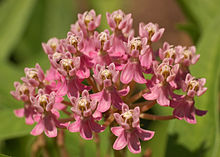
Monarchs are foul-tasting and poisonous due to the presence of cardenolide aglycones in their bodies, which the caterpillars ingest as they feed on milkweed.[17] Both forms advertise their unpalatability with bright colors and areas of high contrast on the skin or wings. This phenomenon is known as aposematism.
Monarchs share this defense with the similar-appearing viceroy butterfly, in an example of Müllerian mimicry. (Viceroys were at one time believed to be Batesian mimics of monarchs.)

Relationship with humans
The monarch is the state insect of Alabama,[18] Idaho,[19] Illinois,[20] Minnesota,[21] Texas,[22] and the state butterfly of Vermont[23] and West Virginia.[24] It was nominated in 1990 as the national insect of the United States of America, along with the honeybee (Apis mellifera),[25] but the legislation did not pass.[26]
Many people like to attract monarchs by growing a butterfly garden with a specific milkweed species. Others enjoy raising them for pleasure or for educational purposes. For migrating flocks, sanctuaries have been created at favorite wintering locations.[27] Even tourism revenue is thus generated.
Many schools also enjoy growing, and attending to monarch butterflies, starting with the caterpillar form. When the butterflies reach adulthood they are then released into the wild.[28]
Threats
Recent illegal deforestation of the monarch's overwintering grounds have led to a drastic reduction in the butterfly's population. Efforts to classify it as a protected species and to restore its habitat are under way. Authorities expected a significant increase in the monarch population in the 2005-2006 season.
Predators
Although monarchs feed on milkweed, variations in the quantity of cardiac glycosides exist between species, individuals and even parts of the host plant. The levels of toxins in adult monarchs reflect the levels in their host plants. This means some monarchs are not foul-tasting but are Batesian or auto-mimics. Some species of predators have learnt to measure the toxins by taste and reject butterflies with high cardiac glycosides contents, eating only the ones with low cardiac glycosides contents. In the butterfly, the cardiac glycosides are concentrated in the abdomen and wings. Some species of predators differentiate these parts and consume only the most palatable ones.[29] Bird predators include Brown Thrashers, Grackles, Robins, Cardinals, Sparrows, Scrub Jays and Pinyon Jays.[29]
In North America, eggs and first instar larvae of the monarch are eaten by larvae and adults of the introduced Asian lady beetle (Harmonia axyridis).[30]

On Oahu, a white morph of the monarch has emerged. This is because of the introduction, in 1965 and 1966, of two bulbul species, Pycnonotus cafer and Pycnonotus jacosus. They are now the most common insectivore birds, and probably the only ones preying on insects as big as the monarch. Monarchs in Hawaii are known to have low cardiac glycoside levels, but the birds may also be tolerant for the chemical. The two species hunt the larvae and some pupae from the branches and underside of leaves in milkweed bushes. The bulbuls also eat resting and ovipositing adults, but rarely flying ones. Because of its colour the white morph has a higher survival rate than the orange one. This is either because of apostatic selection (i.e. the birds have learnt the orange monarchs can be eaten, because of camouflage; the white morph matches the white pubescence of milkweed, or the patches of light shining through foliage, or because the white morph does not fit the bird's search image of a typical monarch, and is thus avoided.[31]
Another problem in North America is the black swallow-wort plant. Monarchs lay their eggs on these plants, thinking it is similar to milkweed. Once the eggs hatch, the caterpillars are poisoned by the toxicity of this invasive plant.
Parasites
Parasites include the tachinid fly Lesperia archippivora. Parasitized larvae complete their moult, suspend, but die before pupation. At that time one white maggot comes out of the larvae, suspended by a silken thread. The maggot then forms a brown pupa on the ground.[32]
The bacteria Micrococcus flacidifex danai also infects the larvae and causes “black death”. As usual, just before pupation the larvae migrate to a horizontal surface. They die a few hours later, attached only by one pair of prolegs, thorax and abdomen hanging limp. The body turns black shortly after. The bacteria Pseudomonas aeruginosa has no invasive powers, but causes secondary infections in weakened insects. It is a common cause of death in laboratory reared insects.[32]
The protozoan Ophryocystis elektroscirrha is another parasite of the monarch. It infects the subcutaneous tissues and propagates by spores formed during the pupal stage. The spores are found over all of the body of infected butterflies, with the greatest number on the abdomen. These spores are passed, from female to caterpillar, when spores rub off during egg-laying and are then ingested by caterpillars. Severely infected individuals are weak, unable to expand their wings, or unable to eclose, and have a shortened lifespan but probably occur a low frequencies in nature. This is not the case in laboratory or commercial rearing, where after a few generations all individuals can be infected.[33]
References
- ^ The Generic Names of British Insects. Royal Entomological Society of London Committee on Generic Nomenclature, Committee on Generic Nomenclature. British Museum (Natural History). Dept. of Entomology. 2007-05-23 [1934]. p. 20. Retrieved 2008-06-04.
{{cite book}}: CS1 maint: others (link) - ^ Scudder, Samuel H. The butterflies of the eastern United States and Canada with special reference to New England. The author. p. 721. Retrieved 2008-06-04.
{{cite book}}: Unknown parameter|coauthors=ignored (|author=suggested) (help); line feed character in|coauthors=at position 47 (help) - ^ a b http://www.amonline.net.au/factsheets/monarch.htm
- ^ a b http://calamvalecreek.awardspace.com/regal.html
- ^ "Wanderer Butterfly". Retrieved 2008-08-27.
- ^ a b Garber, Steven D. (1998). The Urban Naturalist. Courier Dover Publications. pp. 76–79. ISBN 0486403998. Retrieved 2008-05-26.
- ^ a b "Monarch, Danaus plexippus". Retrieved 2008-08-27.
- ^ a b Guppy, Crispin S. Butterflies of British Columbia. UBC press. pp. 352–354. ISBN 0774808098. Retrieved 2008-03-29.
{{cite book}}: Unknown parameter|coauthors=ignored (|author=suggested) (help); Unknown parameter|origdate=ignored (|orig-date=suggested) (help) - ^ Jean, Adams (1992). Insect Potpourri: Adventures in Entomology. CRC Press. pp. 28–29. ISBN 1877743097. Retrieved 2008-05-21.
- ^ Linnaeus, Carolus (1758). Systema Naturae (in Latin). Stockholm: Holmiae (Laurentii Salvii). pp. p.471. OCLC 174638949. Retrieved 2008-02-04.
{{cite book}}:|pages=has extra text (help) - ^ Pyle, Robert Michael (2001). Chasing Monarchs: Migrating with the Butterflies of Passage. Houghton Mifflin Books. pp. 148–149. ISBN 0618127437. Retrieved 2008-05-14.
- ^ a b Smith, David A. (2005). "A classification of Danaus butterflies (Lepidoptera: Nymphalidae) based upon data from morphology and DNA" (PDF). Zoological Journal of the Linnean Society. 144 (2): 191–212. doi:10.1111/j.1096-3642.2005.00169.x. Retrieved 2008-05-19.
{{cite journal}}: Unknown parameter|coauthors=ignored (|author=suggested) (help); Unknown parameter|month=ignored (help) - ^ a b c Braby, Michael F. (2000). Butterflies of Australia: Their Identification, Biology and Distribution. CSIRO Publishing. pp. 597–599. ISBN 0643065911. Retrieved 2008-05-26.
- ^ Oberhauser, Karen S. (2004). The Monarch Butterfly: Biology and Conservation. Cornell University Press. p. 3. ISBN 0801441889. Retrieved 2008-06-03.
{{cite book}}: Unknown parameter|coauthors=ignored (|author=suggested) (help) - ^ "Monarch Life Cycle". Biology. Monarch Watch. Retrieved 2008-06-06.
{{cite web}}: External link in|publisher= - ^ Gugliotta, Guy (2003): Butterflies Guided By Body Clocks, Sun Scientists Shine Light on Monarchs' Pilgrimage. Washington Post, May 23, 2003, page A03. Retrieved 2006-JAN-07.
- ^ a b "ADW: Danaus plexippus: Information". Retrieved 2008-08-27.
- ^ "Official Alabama Insect". Alabama Emblems, Symbols and Honors. Alabama Department of Archives & History. 2001-07-12. Retrieved 2007-03-19.
{{cite web}}: Check date values in:|date=(help) - ^ "Idaho Symbols, Insect: Monarch Butterfly". Idaho State Symbols, Emblems, and Mascots. SHG resources, state handbook & guide. Retrieved 2008-03-26.
- ^ "State Symbol: Illinois Official Insect — Monarch Butterfly (Danaus plexippus)". [Illinois] State Symbols. Illinois State Museum. Retrieved 2008-03-26.
- ^ "Minnesota State Symbols" (PDF). Minnesota House of Representatives. Retrieved 2008-03-26.
- ^ "Texas State Symbols". The Texas State Library and Archives. Retrieved 2008-03-26.
- ^ "(Vermont) State Butterfly". Vermont Department of Libraries. Retrieved 2008-03-26.
- ^ "West Virginia Statistical Information, General State Information" (PDF). Official West Virginia Web Portal. Retrieved 2008-03-26.
- ^ Wade, Nicholas (1990-06-01). "Choosing a National Bug". The New York Times. Retrieved 2008-03-26.
- ^ "Frequently Asked Questions on Entomology". Entomological Society of America. Retrieved 2008-03-26.
- ^ "Saving Butterflies Insect Ecologist Spearheads Creation of Oases for Endangered Butterflies". ScienceDaily. 2005-01-01. Retrieved 2008-05-27.
{{cite web}}: line feed character in|title=at position 19 (help) - ^ "Monarch Watch". The Kansas Biological Survey, Univ of Kansas. 2008-05-27. Retrieved 2008-05-27.
- ^ a b Barbosa, Pedro (1988). "5". Novel Aspects of Insect-plant Interactions. Wiley-Interscience. pp. 29–31. ISBN 0471832766. Retrieved 2008-05-12.
{{cite book}}: Unknown parameter|coauthors=ignored (|author=suggested) (help) - ^ Koch, R. L. (2003). "Susceptibility of immature monarch butterfly, Danaus plexippus (Lepidoptera: Nymphalidae: Danainae), to predation by Harmonia axyridis (Coleoptera: Coccinellidae)". Biological Control. 28 (2): 265–270. doi:10.1016/S1049-9644(03)00102-6. Retrieved 2008-04-23.
{{cite journal}}: Unknown parameter|coauthors=ignored (|author=suggested) (help); Unknown parameter|month=ignored (help) - ^ Stimson, John (1990). "Predator induced colour polymorphism in Danaus plexippus L. (Lepidoptera: Nymphalidae) in Hawaii". Heredity. 65 (3): 401–406. doi:10.1038/hdy.1990.110.
{{cite journal}}:|access-date=requires|url=(help); Unknown parameter|coauthors=ignored (|author=suggested) (help); Unknown parameter|laysummary=ignored (help) - ^ a b Brewer, Jo (1966). "Causes of death encountered during rearing of Danaus plexippus (Danaidae)" (PDF). Journal of the Lepidopterist’s Society. 20 (4): 235–238. Retrieved 2008-04-13.
{{cite journal}}: Unknown parameter|coauthors=ignored (|author=suggested) (help); Unknown parameter|laysummary=ignored (help) - ^ Leong, K. L. H. (1997). "Instar Susceptibility of the Monarch Butterfly (Danaus plexippus) to the Neogregarine Parasite, Ophryocystis elektroscirrha". Journal of Invertebrate Pathology. 69 (1): 79–83. doi:10.1006/jipa.1996.4634.
{{cite journal}}:|access-date=requires|url=(help); Unknown parameter|coauthors=ignored (|author=suggested) (help); Unknown parameter|laysummary=ignored (help)
This article needs additional citations for verification. (December 2007) |
External links
- Video of a monarch butterfly emerging from chrysalis
- Australian Museum fact sheet on monarch butterflies
- Critters of Calamvale Creek — a monarch tells its story
- Monarch Migration Maps
- Monarch Watch of the University of Kansas Entomology Department
- Michoacan Reforestation Fund
- USGS description of monarch butterfly
- MonarchHealth!
- Monarch Butterfly Trust NZ
- Monarch butterfly life cycle photographs
- More Than Monarchs
- Monarch egg eclosion
- http://www.monarchbutterflyusa.com/
- monarch butterfly on the UF / IFAS Featured Creatures Web site




